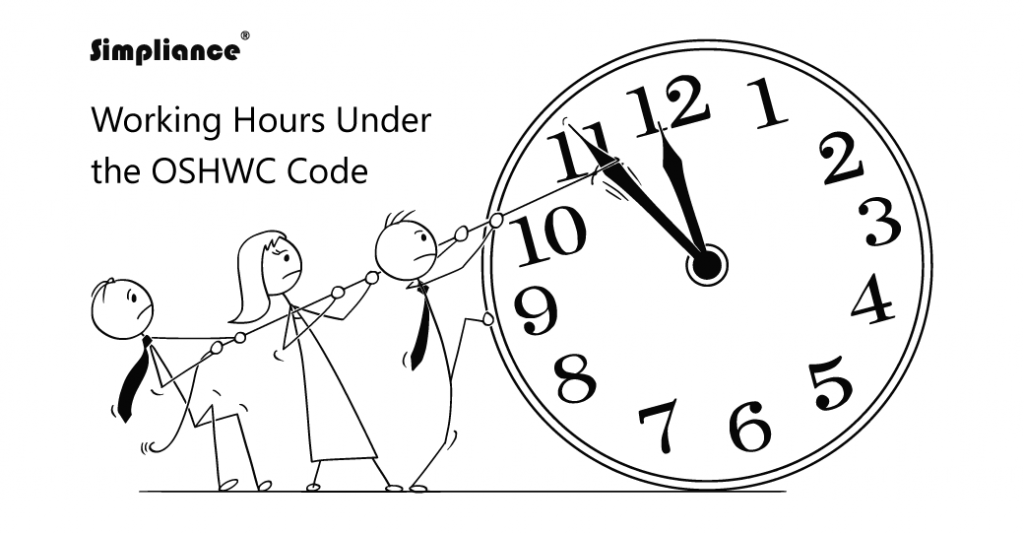
Introduction
The Occupational Safety, Health and Working Conditions Code, 2020 lays down the provisions relating to working hours in establishments. Section-25 under the Code states that no worker shall be required to work for more than eight hours in a day. It also stipulates that the period of work in each day shall be so fixed so as not to exceed such hours, with such intervals and spread overs as may be notified by the appropriate Government.
The draft Occupational Safety, Health and Working Conditions (Central) Rules provide further clarity on daily and weekly working hours as explained in the above section. Rule-28(1) provides that no worker shall be required or allowed to work in an establishment for more than forty-eight hours in any week. It goes on to provide that the period of work of a worker must be arranged in a manner such that spread over is not more than twelve hours inclusive of the intervals for rest. Finally, it stipulates that no worker shall work for more than five hours before he has had an interval of rest for at least half an hour.
This article shall examine the various contours of this move to explain why working hours have not been extended and the difference between working hours and spread over. Following this, the article shall examine international law and empirical data to understand the reason behind the move.
Working Hours vs. Spread over
Several news publications have been running pieces citing the above as an increase in working hours from eight to twelve. Not only is that factually incorrect but it is also based on an erroneous interpretation of the law. As explained above, Section-25 of the OSHWC Code, 2020 clearly states that no worker shall be allowed to work for more than eight hours a day. The reason this misinterpretation occurs is due to a failure to recognize the distinction between working hours and spread over.
Working hours refer to the time a worker spends on duty actually carrying out his tasks whereas spread over refers to the action of distributing work over a period of time. While the two might seem similar the difference lies in the fact that the latter includes time for rest whereas the former does not. Working hours refer to the time spent actually working whereas spread over includes both working hours and hours dedicated to rest.
Therefore, the impact of the OSHWC Code Rules is not to increase working hours but to allow greater flexibility in spread over. Consider the following example, a security guard is employed for two periods- between 8AM to 12AM and 4PM to 8PM. Between these periods he is free to return home or occupy a rest area on the premises. The number of hours worked in the above scenario would be eight hours as he is working for two four-hour periods. Whereas the spread over would be twelve hours as it includes the four hours, he spends off duty.
This will benefit a large number of workers ranging from those engaged in call-centers to female workers who have delivered a child, as it will give them sufficient time to rest at work. Thus, from the above it is clear that the move that is being criticized for being restrictive and repugnant to workers’ interests is actually creating greater flexibility and is providing workers with sufficient rest between their work periods. The benefits of this will become clear in the subsequent sections.
ILO and Working Hours
Working hours have been a key facet of the ILO’s work since its inception and were a part of key labour rights movements. The Hours of Work (Industry) Convention, 1919 is the first international convention on labour and has been followed with numerous instruments that solidify the importance of regulating work time and the dangers of excessive working hours. These include the Hours of Work (Commerce and Offices) Convention, 1930, the Forty-Hour Week Convention, 1935 and the Weekly Rest Conventions of 1921 and 1935, respectively.
India is one of the original members of the ILO and has ratified Hours of Work (Industry) Convention of 1919. Therefore, the eight-hour workday with twelve-hour spread over is in keeping with India’s international obligations.
Is there a link between increased working hours and productivity?
While the above arguments stem from a legal understanding of rights and the development of international law supported by customary recognition of the eight-hour workday, this section aims to ascertain whether increased working hours have a beneficial impact on productivity. A 2014 paper titled ‘The Productivity of Working Hours’ by John Pencavel offers key insights on the above question. He analyses existing literature pertaining to the subject as well as large amounts of data to conclude that long weekly hours and long daily hours do not necessarily yield high output.
The paper also suggests that employers should treat the length of working hours with care because employees at work for a long time may experience fatigue or stress that reduces productivity and also increases the scope for errors, accidents and illness that ultimately impose costs on the employer. The same is applicable generally but varies across different types of work. The paper also argues that in several cases decreased working hours lead to increased productivity and that statutory restrictions on working hours may actually promote productivity as well as well-being of workers.
The author also suggests staggered work timings with lengthy breaks between work periods to ensure productivity remains high. By providing significant scope for spreadover and a mandatory break after five hours of continuous work, the OSHWC Code and its rules are definitely taking cognizance of the same.
Conclusion
From the above it is clear that the change brought in by the Government does not entail an increase in working hours. The Government has merely increased the spread over from ten and a half hours under Section-56 of the Factories Act, 1948 to twelve hours under the OSHWC Code read with its rules. The same shall have a beneficial impact by enabling employers to give their workers longer breaks and ensure they are given adequate rest between work periods. This wasn’t possible earlier as the eight-hour workday and breaks had to be compressed within the ten-and-a-half-hour threshold. And as seen in the above illustration, the same would be problematic for those working because they would be forced to take shorter breaks, or their employers would be forced to pay overtime. Therefore, the hyperbole surrounding the same is unwarranted in the author’s opinion and the move should be welcomed as it benefits both the worker and the employer.
However, there is scope for the same to be misused and therefore the onus is on the implementing authorities under the Code to ensure that workers are not made to work for more than eight hours in a day and are given adequate rest as part of their spread over under the Code.
Have you as an employer experimented with working hours? Do you believe the concept of work needs to be revisited? What do you believe will be the next challenges in the future of work?
Drop your thoughts in the comments below.
Disclaimer: This blog is meant for informational purposes and discussion only. It contains only general information about legal matters. The information provided is not legal advice and should not be acted upon without seeking proper legal advice from a practicing attorney.
Simpliance makes no representations or warranties in relation to the information on this article.

Animay Singh
Biography

Dear sir, working hours as 8 hours is being thoroughly debated more than sufficient during the transition period of the history of 12 hours working day to 8 hours working day. Working hours are basically decided keeping in view the overall good and healthy life of the worker/employee by balancing his/her obligations towards personal life and employment. Keeping this in mind, the spread over time is also limited to only one hour or one and half hour wherein an employee can reasonably take rest at work place itself. But spread over of 4 hours will certainly disturb the personal life of the employee as he can neither take rest nor utilize the long spread over for discharging the personal, family responsibilities. Govt. conveniently ignoring the fact that majority of the work force is being engaged by small and medium level industries in India, where even bare necessities of toilets, lunch rooms are not being provided even till date. As such, narrating a colourful rest in such a long spell is a nightmare in practice and aimed at satisfying the employers’ urge to extend the working hours legally. The evil thought behind this should not be put forward by quoting ILO conventions against its original intentions. Shortening of time for personal life will lead to disability to discharge workmen family obligations thereby less attention towards the family and its well being which ultimately leads to worst social conditions. Let us not aim at bringing back the unlimited working hours indirectly in the name of facility i.e., long spell of rest.
Let us try to establish a society which is potential, healthy and responsible.
This spread over for benefit for Employer not for workmen. Please give rest only half hour or maximum one and half hour only otherwise misuse by employer